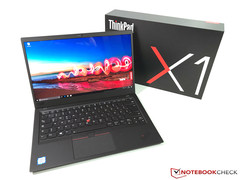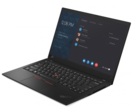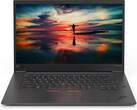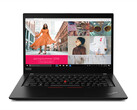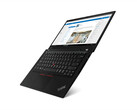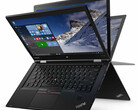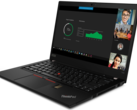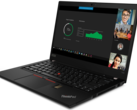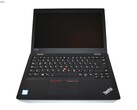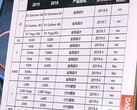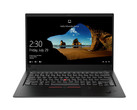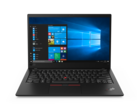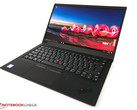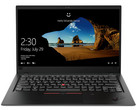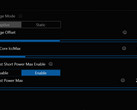It is often not easy to make the right decision if manufacturers offer multiple components. They often limit their advertising to the high-end SKUs, especially in terms of the display. However, this is not always the best choice for your daily office tasks. This is also the case for Lenovo's current flagship device, the 6th generation of the 14-inch ThinkPad X1 Carbon. Notebookcheck had the chance to test all four different models and we can now give our recommendation.
The base display of the ThinkPad X1 Carbon is a matte 1080p screen based on the IPS technology, which is also available as a touchscreen (+ $85.00). The next option is the matte WQHD screen (2560x1440 pixels, + $138.00), which we already know from the 2017 X1 Carbon. The glossy WQHD panel (+ $180.00) is new for this generation, and it is particularly bright with wider color gamut. Lenovo does not use PWM for the brightness regulation on any of the panels, so there is no annoying screen flickering.
We will summarize the pros/cons of each display below, but we recommend our comprehensive reviews of the X1 Carbon 2018 for more information on our test models:
| WQHD matte LP140QH2-SPB1, 2560x1440 | WQHD glossy B140QAN02.0, 2560x1440 | FHD B140HAN03.1, 1920x1080 | FHD Touch Lenovo LEN40A9 / AUO B140HAK02.3, 1920x1080 | |
|---|---|---|---|---|
| Display | 19% | -12% | -5% | |
| Display P3 Coverage (%) | 72.7 | 87.7 21% | 63.3 -13% | 68.3 -6% |
| sRGB Coverage (%) | 97.9 | 100 2% | 89.4 -9% | 94.9 -3% |
| AdobeRGB 1998 Coverage (%) | 74.6 | 99.9 34% | 64.4 -14% | 69.3 -7% |
| Response Times | -44% | -16% | -1% | |
| Response Time Grey 50% / Grey 80% * (ms) | 38 ? | 59.2 ? -56% | 45.6 ? -20% | 40 ? -5% |
| Response Time Black / White * (ms) | 26 ? | 34.4 ? -32% | 28.8 ? -11% | 25 ? 4% |
| PWM Frequency (Hz) | ||||
| Screen | 43% | 9% | 24% | |
| Brightness middle (cd/m²) | 316 | 578 83% | 330 4% | 298 -6% |
| Brightness (cd/m²) | 311 | 533 71% | 311 0% | 287 -8% |
| Brightness Distribution (%) | 84 | 84 0% | 87 4% | 91 8% |
| Black Level * (cd/m²) | 0.35 | 0.38 -9% | 0.21 40% | 0.2 43% |
| Contrast (:1) | 903 | 1521 68% | 1571 74% | 1490 65% |
| Colorchecker dE 2000 * | 4.5 | 1.9 58% | 4.7 -4% | 2.19 51% |
| Colorchecker dE 2000 max. * | 10.3 | 3.8 63% | 9.3 10% | 4.39 57% |
| Colorchecker dE 2000 calibrated * | 1.6 | 0.8 50% | 2.4 -50% | 1.67 -4% |
| Greyscale dE 2000 * | 7.7 | 3 61% | 4.5 42% | 1.97 74% |
| Gamma | 2.2 100% | 2.14 103% | 1.99 111% | 2.43 91% |
| CCT | 6639 98% | 6377 102% | 6710 97% | 6571 99% |
| Color Space (Percent of AdobeRGB 1998) (%) | 68.6 | 88.8 29% | 58.2 -15% | 62 -10% |
| Color Space (Percent of sRGB) (%) | 97.9 | 100 2% | 89.3 -9% | 95 -3% |
| Total Average (Program / Settings) | 6% /
28% | -6% /
2% | 6% /
16% |
* ... smaller is better
Full-HD IPS & Touchscreen
The two 1080p screens are provided by AU Optronics and there are no major differences in terms of specs except for the additional touch layer. The brightness is at around 300 nits, and you can still use it outdoors thanks to the matte panel surface. The low black value is another advantage, and it results in an excellent contrast ratio in combination with the decent luminance. The picture appears a bit grainy on especially on bright surfaces, which is not uncommon for matte panels. The color accuracy ex-works is completely sufficient for common office tasks, and a calibration is not mandatory. Thanks to their lower resolution, the FHD panels also consume less power, which helps the battery runtime.
WQHD IPS with matte surface
The optional WQHD panel with the matte surface features a resolution of 2560x1440 pixels. The screen from LG Philips sets you back $138.00 and the subjective picture quality is superior to the 1080p models. Bright areas are very clear (not grainy) and contents appear a bit sharper thanks to the higher resolution. It is also a bit brighter, but the black value is higher as well, which results in a lower contrast ratio. Our test model was not calibrated very well out of the box and we noticed a slight green color cast, but the results after our calibration are excellent. It is even possible to edit some pictures/videos thanks to the nearly full sRGB coverage.
WQHD HDR IPS with glossy surface
The optional WQHD panel with the glossy surface and HDR support is the most expensive option ($180.00) and the best screen based on the specs. The panel from AU Optronics manages an excellent average luminance of 530 nits in combination with high contrast ratio and excellent color accuracy after the calibration. It also covers most of the wider AdobeRGB gamut, so it is really worth the additional price and not too expensive.
However, the display has to drawbacks, which can be important depending on your usage scenario. The response times are very slow, and you will see some ghosting. You get used to this, even though the subjective perception can differ. The biggest issue is the very glossy screen surface. It does create a very rich picture, but is very hard to use outdoors. Even reflections from light sources indoors can be an issue.
Our Recommendation: A matte panel is better for work
Lenovo's ThinkPad X1 Carbon is primarily an office device, which is also a good choice for field workers or sales representatives thanks to its compact chassis and low weight. With this in mind, we would always recommend a matte screen. We prefer the subjective picture impression of the higher-resolution WQHD panel (sharper image, not grainy), so we recommend this model. However, it should be calibrated if possible.
The optional WQHD HDR screen might also be interesting for some users, at least if you can live with the drawbacks. The wide color gamut is certainly an advantage and you will enjoy the display if you do not only use your laptop for work, but also afterwards for some video/movie playback.




